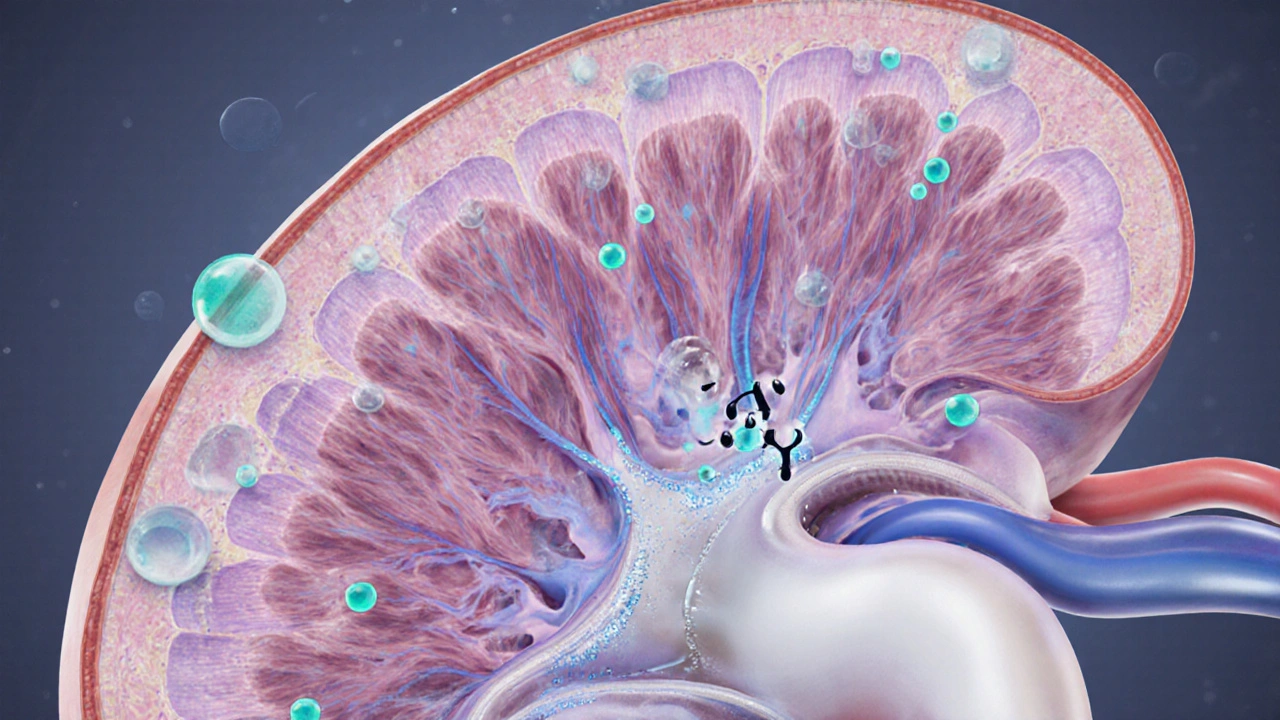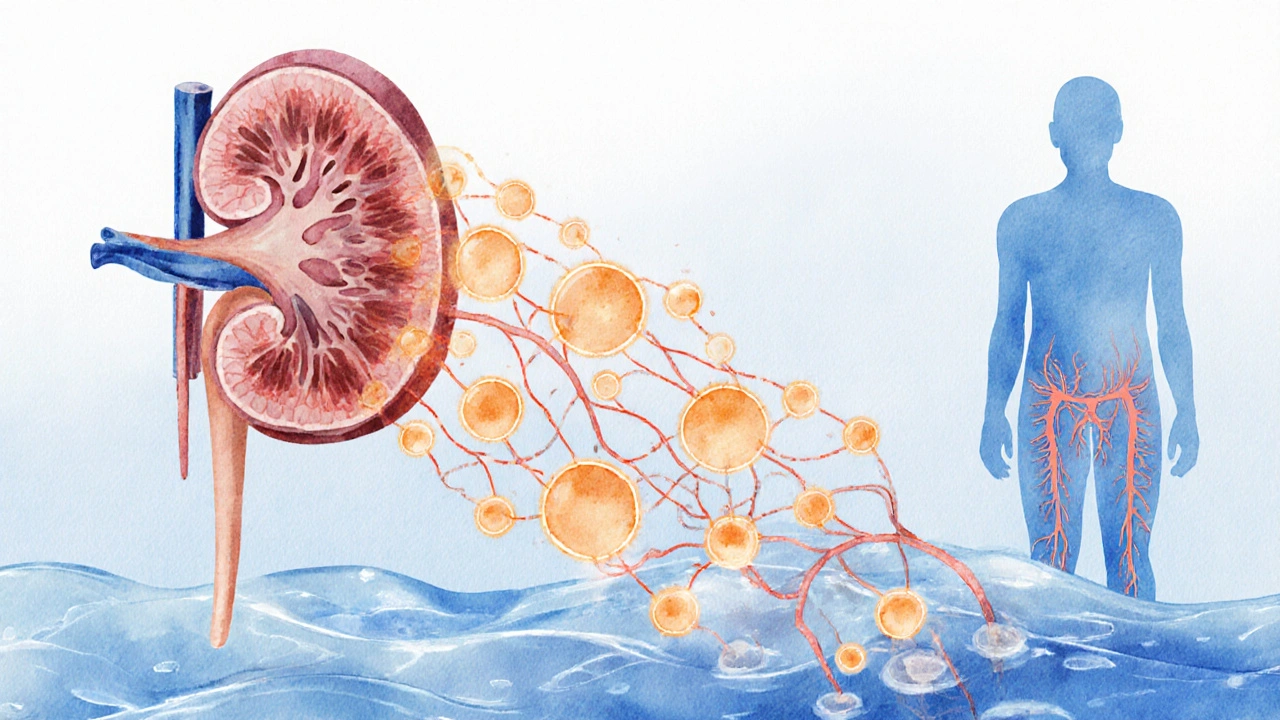How Hyponatremia Accelerates Kidney Disease Progression
 Oct, 13 2025
Oct, 13 2025
Hyponatremia Correction Calculator
Safe Sodium Correction Calculator
Based on clinical guidelines for patients with chronic kidney disease (CKD)
Correction Recommendations
Safe & EffectiveMaximum safe correction rate:
Estimated time to reach target:
Important Safety Note
Correction rate must not exceed 8-10 mmol/L in 24 hours or 18 mmol/L in 48 hours to prevent complications like osmotic demyelination syndrome.
Low blood sodium isn’t just a lab curiosity; it can be a hidden driver that speeds up the decline of kidney function. If you’ve ever wondered why patients with chronic kidney disease (CKD) suddenly worsen, the answer often lies in how the body handles water and electrolytes.
What is hyponatremia?
When serum sodium drops below the normal range of 135‑145mmol/L, Hyponatremia a condition marked by diluted blood sodium that leads to cellular swelling and a cascade of hormonal responses occurs. It can develop quickly in hospital settings or creep in slowly for people on certain medications.
Kidney disease at a glance
Kidney disease covers a spectrum from Chronic kidney disease (CKD) a long‑term loss of glomerular filtration rate (GFR) that usually progresses over years to acute episodes known as Acute kidney injury (AKI) a sudden drop in kidney function often triggered by ischemia, toxins, or severe fluid shifts. Both stages share a vulnerability to disturbances in fluid and electrolyte balance.
How low sodium messes with kidney physiology
Sodium the primary extracellular cation that regulates plasma osmolality and fluid distribution is a key player in kidney homeostasis. When sodium levels fall, the body releases Antidiuretic hormone (ADH) a hormone that makes the collecting ducts re‑absorb water, concentrating urine. The result is water retention, increased intravascular volume, and a higher chance of Fluid overload excess fluid that raises blood pressure and stresses the kidneys.
Two additional pathways amplify the harm:
- The Renin‑angiotensin‑aldosterone system (RAAS) a hormonal cascade that raises sodium re‑absorption and systemic vascular resistance can become over‑active, leading to hypertension and further glomerular injury.
- Common Diuretics medications that increase urine output, often used in heart failure and CKD, can precipitate hyponatremia if not carefully dosed.

Clinical evidence linking hyponatremia to worsening kidney function
Large cohort studies from the United States and Europe have consistently shown that patients presenting with serum sodium < 130mmol/L have a 1.8‑fold higher risk of progressing to end‑stage renal disease (ESRD) within three years. A 2023 analysis of 45,000 CKD patients found that each 5‑mmol/L drop in sodium was associated with a 12% increase in the annual decline of estimated GFR.
In acute settings, hyponatremia often co‑exists with AKI. The fluid shifts that accompany low sodium reduce renal perfusion pressure and trigger tubular cell injury. A meta‑review of postoperative patients revealed that those who developed hyponatremia were 2.3 times more likely to need renal replacement therapy.
Managing hyponatremia in patients with kidney disease
Effective management hinges on three pillars: identifying the cause, correcting the sodium deficit safely, and preventing recurrence.
- Diagnostic work‑up: Measure serum osmolality, urinary sodium, and assess volume status. Distinguish between hypovolemic, euvolemic, and hypervolemic hyponatremia.
- Therapeutic correction: For mild cases (130‑135mmol/L) limit free water intake and adjust diuretic doses. Moderate‑severe cases (<130mmol/L) may require hypertonic saline administered at a controlled rate (usually 100mL of 3% NaCl over 10‑20minutes, then reassess).
- Long‑term strategies: Use vasopressin antagonists (e.g., tolvaptan) in patients where ADH‑driven water retention dominates. Implement low‑dose loop diuretics combined with potassium‑sparing agents to balance sodium and potassium.
All interventions must consider the patient’s residual kidney function; overly rapid correction can precipitate osmotic demyelination, especially in chronic hyponatremia.
Prevention tips for clinicians and patients
- Regularly monitor serum sodium in anyone with CKD stage3 or higher, especially if on thiazide or loop diuretics.
- Avoid excessive free‑water intake in patients with heart failure who also have reduced renal clearance.
- Educate patients about the signs of low sodium-headache, confusion, nausea-and advise prompt medical review.
- Optimize blood pressure control to reduce RAAS‑mediated sodium retention.
- When possible, choose diuretics with a lower propensity for causing hyponatremia, such as spironolactone, and titrate cautiously.

Quick Takeaways
- Hyponatremia (hyponatremia) is a strong, independent predictor of faster CKD progression.
- Low sodium triggers ADH release, fluid overload, and RAAS activation-each harms the kidneys.
- Early detection and gentle correction can slow GFR decline and reduce the need for dialysis.
- Regular sodium monitoring should be a standard part of CKD management protocols.
Comparison of hyponatremia types and kidney outcomes
| Type | Typical Mechanism | Serum Na⁺ Range | Effect on Kidney |
|---|---|---|---|
| Hypovolemic | Loss of both water and sodium (e.g., GI losses, over‑diuresis) | 120‑129mmol/L | Reduced renal perfusion → AKI risk |
| Euvolemic (SIADH) | Excess ADH causing water retention without edema | 125‑134mmol/L | Fluid overload → ↑ intra‑glomerular pressure |
| Hypervolemic | Heart failure or cirrhosis; water > sodium | 115‑124mmol/L | Chronic congestion → faster CKD progression |
Frequently Asked Questions
Can mild hyponatremia be ignored in CKD patients?
No. Even mild hyponatremia (130‑134mmol/L) has been linked to a measurable increase in yearly GFR decline. Regular monitoring and early intervention are recommended.
What is the safest rate to correct hyponatremia in CKD?
Raise serum sodium by no more than 8‑10mmol/L in the first 24hours and 18mmol/L in 48hours. Slower correction reduces the risk of osmotic demyelination, which is especially dangerous in chronic cases.
Are vasopressin antagonists safe for long‑term use?
Tolvaptan has shown benefit in controlling euvolemic hyponatremia, but liver‑function monitoring is required. Use it when ADH‑driven water retention is the primary driver and other measures fail.
How do diuretics contribute to low sodium?
Loop and thiazide diuretics increase renal sodium loss, which can outpace water loss, especially if fluid intake is unrestricted. Adjust dosages or pair with a sodium‑containing beverage if needed.
What lifestyle changes help prevent hyponatremia?
Limit excessive water consumption (especially >3L/day) if you have advanced CKD, maintain a balanced diet with adequate salt, and avoid binge‑drinking alcohol, which can increase ADH release.

tierra hopkins
October 13, 2025 AT 20:36Thanks for breaking this down – I hadn’t realized how sneaky low sodium can be for kidney health. It’s eye‑opening to see the link between fluid overload and the RAAS system. Keeping an eye on sodium levels feels like a simple habit that could save a lot of trouble later. I’ll make sure my patients know to watch their water intake and not over‑diurese. Let’s keep spreading the word so more folks catch this early.
Ryan Walsh
October 15, 2025 AT 00:23Great post! If you’re new to the topic, just remember that “low sodium” means the blood is too diluted, not just “not salty enough.” The calculator you shared is a handy tool for figuring out safe correction rates. Talk to your doctor before changing anything, especially if you’re on diuretics.
Karl Norton
October 16, 2025 AT 04:09Honestly, this is just another re‑hash of old nephrology textbooks. The “new calculator” isn’t magic; it just repeats guidelines we’ve had for years. If you’re looking for groundbreaking insight, you won’t find it here.
dee gillette
October 17, 2025 AT 07:56While the article presents hyponatremia as a driver of renal decline, one might argue that it is merely a marker of underlying volume dysregulation. The cited epidemiological data do not differentiate cause from correlation, leaving the true mechanistic role ambiguous. Moreover, the recommended correction thresholds echo existing protocols without offering novel therapeutic avenues. It would be prudent to consider patient heterogeneity when applying a uniform correction strategy. Until such stratified analyses emerge, enthusiasm should be tempered.
Jasin P.
October 18, 2025 AT 11:43Oh sure, just “watch your water intake” and the kidneys will behave like obedient soldiers. As if the body isn’t a complex orchestra of hormones that love to throw a tantrum when you meddle with sodium. Perhaps the real secret is to stop treating physiology like a DIY home‑improvement project. But hey, keep the optimism flowing, it’s contagious.
Lily Đàn bà
October 19, 2025 AT 15:29The drama of low sodium is nothing compared to the real battles we face with health policy. Our hospitals still ignore basic electrolyte monitoring while politicians argue over budgets. When you finally get a calculator, it feels like a token gesture from a broken system. Yet the truth remains: without systemic change, these “safe correction rates” are just band‑aid solutions. We need a revolution, not a calculator.
Joseph O'Sullivan
October 20, 2025 AT 19:16Ever think about how sodium is like the silent referee in the game of fluids? When it drops, the whole team – kidneys, heart, brain – starts playing out of position. The calculator is a nice cheat‑sheet, but the real wisdom lies in listening to the body’s signals. Sometimes the simplest thing, like checking urine output, tells you more than any algorithm. So keep the tech, but never ditch the bedside intuition.
Conor McCandless
October 21, 2025 AT 23:03Hyponatremia is not merely a lab number it is a narrative of fluid imbalance that unfolds silently in the cortex of the kidney. The kidneys, ever vigilant, respond to low extracellular sodium by secreting antidiuretic hormone a response that seems protective at first glance. Yet this hormonal surge forces water reabsorption and dilutes the plasma further feeding a vicious loop. The renin angiotensin aldosterone system, another ancient regulator, awakens and raises vascular resistance amplifying the strain on glomeruli. Diuretics, prescribed with good intentions, can tip the scales toward excessive sodium loss especially when patients increase free water intake. Each of these pathways interlaces like threads in a tapestry creating a pattern of progressive injury that is often underappreciated. Clinical studies have quantified this risk showing that each five millimole drop in serum sodium corresponds to a measurable acceleration in eGFR decline. The data also reveal that patients who develop hyponatremia in the postoperative setting are more likely to require dialysis sooner. Mechanistically the reduction in perfusion pressure during hyponatremic states leads to tubular epithelial stress and necrosis. Furthermore the osmotic stress on cells can trigger inflammation and fibrosis that scar the kidney architecture. The calculator presented in the article offers a pragmatic tool to stay within safe correction limits and avoid the dreaded osmotic demyelination syndrome. However the tool does not replace careful assessment of volume status which remains the cornerstone of management. Physicians must weigh the risks of rapid correction against the dangers of prolonged hyponatremia that perpetuates fluid overload. In practice this means frequent monitoring of serum sodium and adjusting fluid prescriptions accordingly. Ultimately the battle against hyponatremia is a battle for equilibrium and preserving renal function for as long as possible.
kat gee
October 23, 2025 AT 02:49Sounds like a solid plan.
Courtney Payton
October 24, 2025 AT 06:36While sarcasm can be entertaining it also distracts from the real ethical duty we have toward patients. If we ignore the physiological facts in favor of witty retorts we risk compromising care. The moral imperative is to prioritize evidence based practice over snark. Let’s keep the jokes aside when lives are at stake.